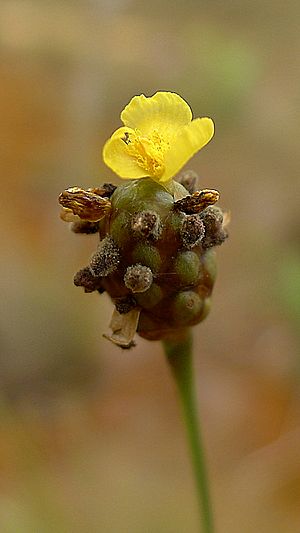Xyris jupicai facts for kids
Quick facts for kids Xyris jupicai |
|
|---|---|
 |
|
| Scientific classification | |
| Genus: |
Xyris
|
| Species: |
jupicai
|
| Synonyms | |
|
List
Xyris acuminata Miq. ex Steud.
Xyris anceps Pers. 1805 not Lam. 1791 Xyris arenicola Miq. Xyris communis Kunth Xyris gymnoptera Griseb. Xyris jupicae Michx. Xyris jupicai var. brachylepis Malme Xyris jupicai var. humilis (Kunth) Malme Xyris laxifolia var. minor Mart. Xyris laxifolia var. sellowiana (Kunth) Seub. Xyris macrocephala Vahl Xyris macrocephala f. minor (Mart.) Malme Xyris macrocephala var. minor (Mart.) L.A.Nilsson Xyris macrocephala f. minor (Mart.) M. Kuhlm. & Kuhn Xyris partita Chapm. ex Ries Xyris sellowiana Kunth Xyris sellowiana f. humilis Kunth Xyris surinamensis Miq. 1843 not Spreng. 1828 |
|
Xyris jupicai, also known as Richard's yellow-eyed grass, is a beautiful flowering plant. It belongs to the yellow-eyed-grass family. This plant is found all over the Americas, from North America down to South America, including Central America and the Caribbean islands.
Contents
Discover Richard's Yellow-Eyed Grass
Richard's yellow-eyed grass is a type of plant that grows back year after year. It can reach a height of up to 100 centimeters (about 40 inches). Imagine a plant taller than many kids your age!
What Does It Look Like?
This plant has long, thin leaves that look a lot like grass. These leaves can grow up to 60 centimeters (about 2 feet) long. The most striking feature of Xyris jupicai is its bright yellow flowers. These cheerful flowers add a splash of color wherever the plant grows.
Where Does It Grow?
Xyris jupicai is a very common plant across a huge area. You can find it in many different places:
- In the southeastern parts of the United States, like Texas, Oklahoma, and New Jersey.
- Throughout Central America.
- On many islands in the Caribbean.
- Across a large part of South America.
This wide distribution shows how adaptable this plant is to different environments. It often grows in wet, sunny areas like bogs, marshes, or along the edges of ponds.
Life Cycle of Yellow-Eyed Grass
As a perennial herb, Xyris jupicai has a life cycle that repeats each year. It grows from its roots, produces leaves and flowers, and then makes seeds. Even after the top part of the plant dies back in colder weather, the roots stay alive underground. This allows the plant to grow new shoots when the warmer seasons return. The yellow flowers are important for reproduction, as they attract pollinators like insects, which help the plant make new seeds.

